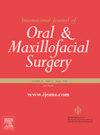种植体植入后唇骨吸收的影响因素与同步引导骨再生:锥形束计算机断层扫描回顾性研究。
IF 2.7
3区 医学
Q2 DENTISTRY, ORAL SURGERY & MEDICINE
International journal of oral and maxillofacial surgery
Pub Date : 2024-10-24
DOI:10.1016/j.ijom.2024.10.008
引用次数: 0
摘要
这项回顾性研究探讨了影响上颌前牙唇骨吸收的因素,这些因素发生在种植体植入 6 个月后,并同时引导骨再生。该研究共涉及 79 名患者(118 个种植体),使用锥形束计算机断层扫描测量了术后即刻和 6 个月后的唇骨水平宽度和垂直尺寸。广义线性混合模型分析了潜在的影响因素:年龄、性别、种植部位、植入时间、术后种植体平台水平的颊骨宽度、种植体连接和骨缺损形态。在 6 个月时,患者出现了明显的骨吸收。统计分析显示,种植体平台处的颊骨宽度、种植体连接和骨缺损形态对唇骨吸收有显著影响,而患者的年龄、性别、植入时间和植入部位则没有影响。颊骨宽度≥2 毫米的种植体的唇侧水平和垂直骨吸收明显较少(水平 P < 0.001,垂直 P = 0.001),与覆盖螺丝相比,愈合基台可减少吸收(水平 P = 0.002,垂直 P = 0.034)。在引导骨再生后,非包含性骨缺损的垂直吸收更明显(P = 0.040)。本文章由计算机程序翻译,如有差异,请以英文原文为准。
Factors influencing labial bone resorption after implant insertion with simultaneous guided bone regeneration: retrospective cone beam computed tomography study
This retrospective study examined factors influencing labial bone resorption in the anterior maxilla 6 months after implant insertion with simultaneous guided bone regeneration. Involving 79 patients (118 implants), the study measured labial horizontal bone width and vertical dimensions using cone beam computed tomography scans taken immediately after surgery and at 6 months. A generalized linear mixed model analyzed potential influencing factors: age, sex, implant site, timing of placement, buccal bone width at the implant platform level post-surgery, implant connection, and bone defect morphology. Significant bone resorption was noted at 6 months. The statistical analysis revealed that buccal bone width at the implant platform, implant connection, and bone defect morphology significantly impacted labial bone resorption, while patient age, sex, timing of placement, and implant site did not. Implants with a buccal bone width ≥2 mm showed significantly less labial horizontal and vertical bone resorption (horizontal P < 0.001, vertical P = 0.001), and healing abutments reduced resorption compared to cover screws (horizontal P = 0.002, vertical P = 0.034). More significant vertical resorption occurred in non-contained bone defects after guided bone regeneration (P = 0.040).
求助全文
通过发布文献求助,成功后即可免费获取论文全文。
去求助
来源期刊
CiteScore
5.10
自引率
4.20%
发文量
318
审稿时长
78 days
期刊介绍:
The International Journal of Oral & Maxillofacial Surgery is one of the leading journals in oral and maxillofacial surgery in the world. The Journal publishes papers of the highest scientific merit and widest possible scope on work in oral and maxillofacial surgery and supporting specialties.
The Journal is divided into sections, ensuring every aspect of oral and maxillofacial surgery is covered fully through a range of invited review articles, leading clinical and research articles, technical notes, abstracts, case reports and others. The sections include:
• Congenital and craniofacial deformities
• Orthognathic Surgery/Aesthetic facial surgery
• Trauma
• TMJ disorders
• Head and neck oncology
• Reconstructive surgery
• Implantology/Dentoalveolar surgery
• Clinical Pathology
• Oral Medicine
• Research and emerging technologies.

 求助内容:
求助内容: 应助结果提醒方式:
应助结果提醒方式:


